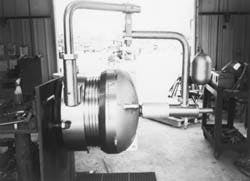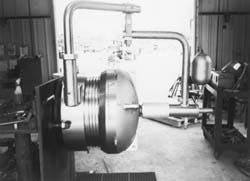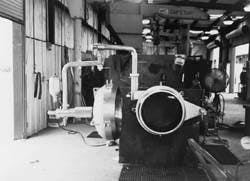SUBSEA TECHNOLOGY Subsea pig launcher set up after platform removed
Double seal and grease injection ports keep out water, seals in pressure on dead-ended pipeline
Once per year, Transcontinental Gas Pipe Line Corporation (TGPL) engineers like to clear the company's South Marsh Island, Block 23, subsea natural gas pipeline of any fluids that may have accumulated during the previous 12 months. Until this year, they did this by launching a pig between two offshore drilling platforms.
In the spring of 1994, the production platform TGPL had been using to launch the pig was moved - dead-ending that part of the company's 20-in. outside diameter pipeline in open water.
At that time, TGPL engineers and the J.M. Huber Corporation of Tomball, Texas developed a solution. The two companies designed a horizontal closure subsea system (ANSI 900 Huber-Yale Figure 500R) that could be used to launch a pig underwater.
The 24-in. stainless and carbon steel closure was fitted with a double-seal cap and hub connection to offset subsea pressure, a diver-friendly actuation device, and a series of injection ports and valves used to purge water entering the closure while open.
Ron Hoepner, manager of pipeline design for TGPL said the closure represented the best solution for the circumstances. Rather than remove the entire leg of the pipeline system from service, or operate very inefficiently, a decision was made to install a subsea launcher.
The subsea design has a threaded cap and hub sealing system. Engineers designed a double seal on the cap and hub connection. An internal seal is achieved by a 23-in. inside diameter rubber 0-ring set in the tapered face of the hub. An external seal, engineered specifically for this application, is formed by a 27-in. ID rubber 0-ring on a set in the flat face of the cap.
"The closure was modified from a standard closure to provide lubricant at positive pressure around the cap pin," said Randall Ray, project engineer for Huber. "Rather than a standard, smooth cap pin held in place by a pair of set collars, the subsea cap pin is threaded, and encased in a lubricated bushing assembly to ensure that no water leaks into the assembly during operation of the closure. The lubricated cap pin rotates with the cap and keeps the chamber closed and charged with pressure." The cap pin is about two feet long and made of carbon steel.
Six injection fittings were added to the perimeter of the cap so that grease could be injected into the threads to purge sea water after operation. "Injecting grease into the button-head fittings until grease is extruded through a purge valve gives the divers positive verification that all air and water has been purged from the closure," Ray said.
At 90 ft below the surface, water pressure adds 40-50 psi on the closure above normal external pressure, so the chamber around the cap pin threads had to be pressurized to offset that pressure. This is accomplished with a 100 psi internal nitrogen charge, carried in an accumulator attached to the jib assembly (a swinging arm supporting the cap and attached to the hub). Plug and check valves are plumbed into the jib assembly to allow divers to recharge the accumulator with pressure as necessary.
"A nitrogen charge is also used to launch pigs from the assembly," said Hoepner. "A quick burst of pressure injected into the closure starts the pig traveling, and the natural gas in the pressurized line keeps it moving until it reaches the pig capture assembly on the offshore rig." The closure has a 22 5/8-in. internal bore and is rated to 2,165 psi at 130F. TGPL's normal operating pressure is 1,000 psi in this area.
A 3.5-in. OD bronze bushing secures the cap pin. The bushing housing also serves as a support base to prop the closure open when inserting a pig. "A two-in. pipe about four feet long can be used to maintain the proper balance of the cap during opening and closing," Ray added.
The threaded cap pin/bushing housing is kept charged with lubricant to ease operation and protect against corrosion. When the cap is opened, the cap pin threads into the bushing housing, displacing lubricant directly into the accumulator, the project engineer says. "There is a rubber bladder inside the accumulator which holds the nitrogen, preventing the gas and lubricant from mixing," he said.
Where the closure is welded to the pipeline, a cathodic protection ring was added to the existing closure design in order to prevent corrosion of the unit. To further protect against corrosion, all external closure parts have three-mm thickness electroless nickel plating."
The land version of the closure is opened with a ratchet motion difficult to attain underwater, so the operating mechanism of the closure was modified for underwater conditions. Huber engineers designed a hex boss on the end of the actuation nut. Divers lever the hex boss with a specially designed impact wrench to break open the closure. The wrench, or closure actuation tool is designed to fit into lugs on the perimeter of the cap.
In contrast. the existing technology for subsea launchers involves a blind flange end connection. This is essentially a cap bolted onto the end of the pipeline that would have to be unbolted for each operation, Hoepner said. The 24-in. ANSI 900 blind flange ends have 20 bolts. All of which would have be removed to allow insertion of the pig and replaced to close the pipeline," he said. "The flanged connection may have lower up-front costs, but the real expense in operations such as this is labor.
Copyright 1995 Offshore. All Rights Reserved.


